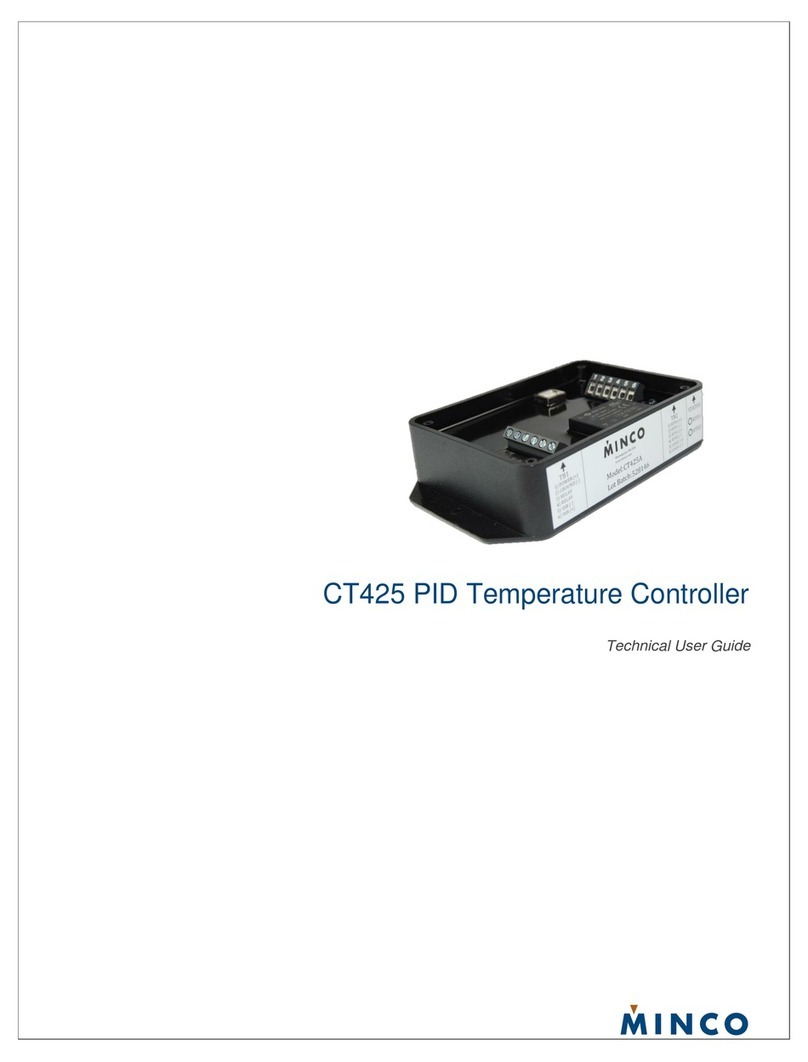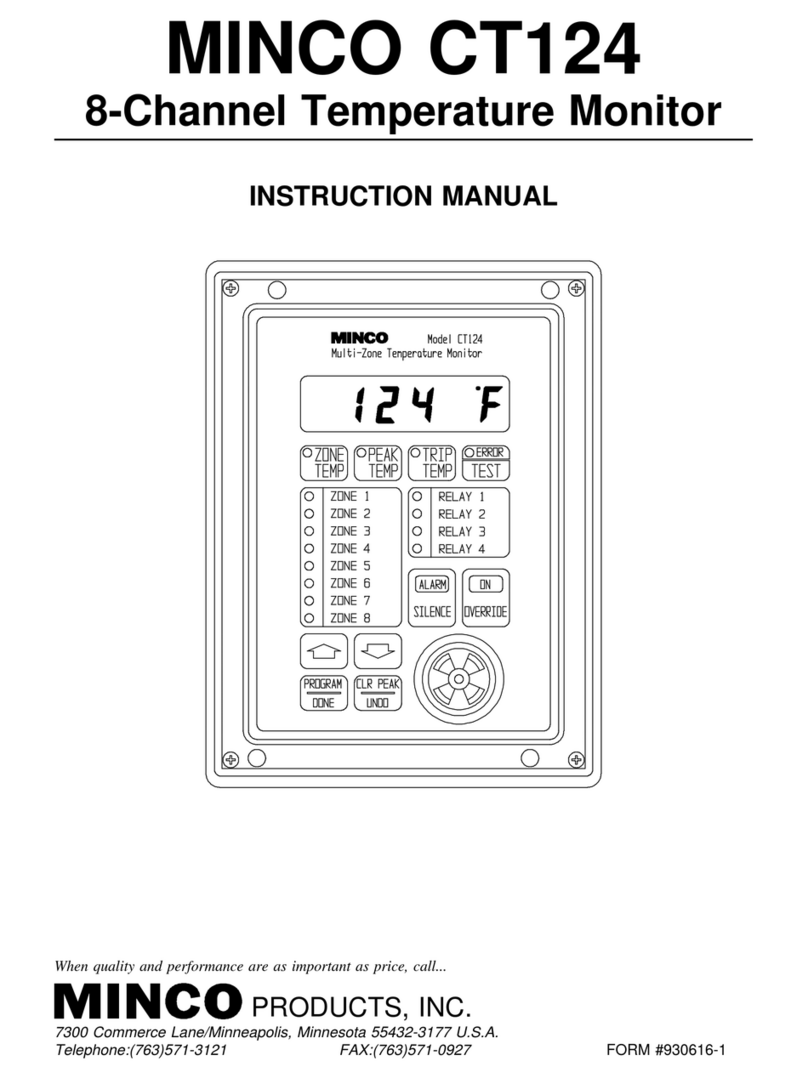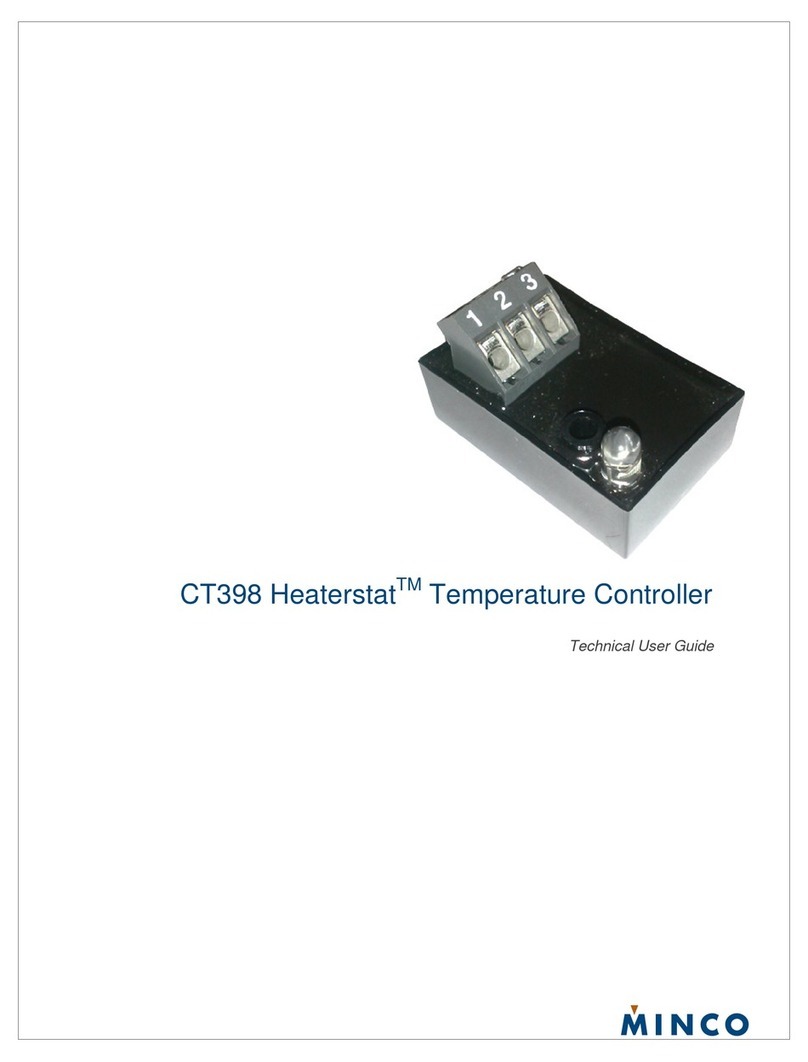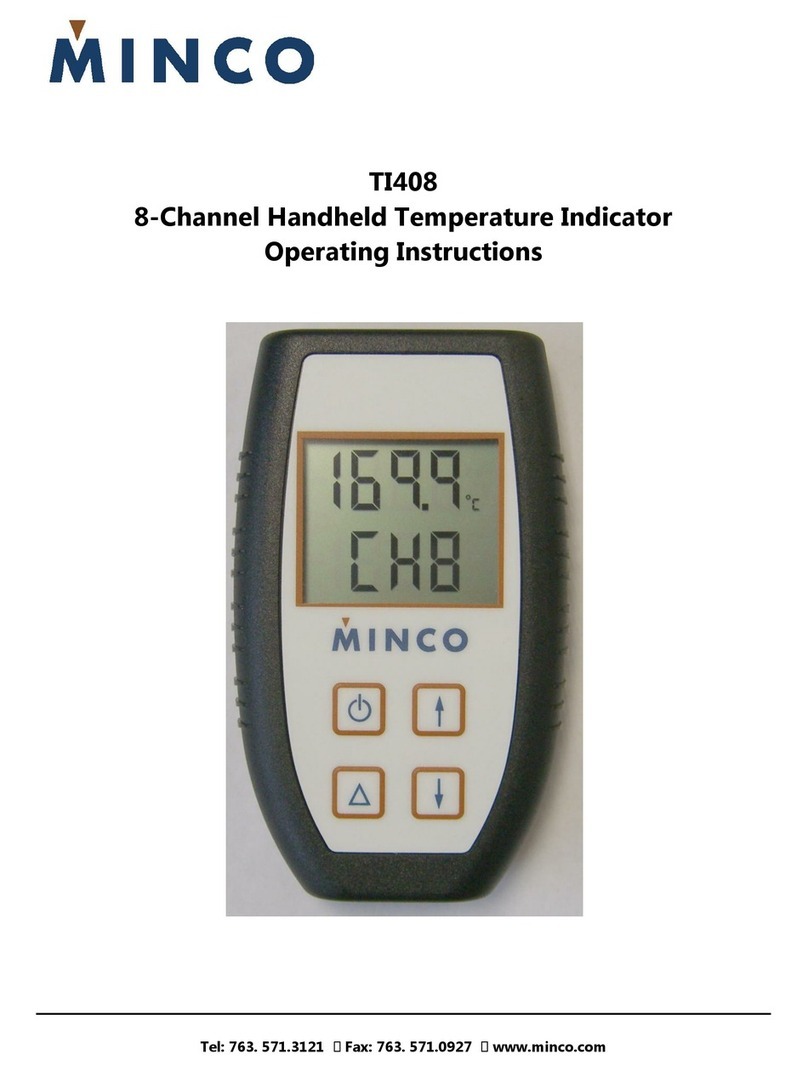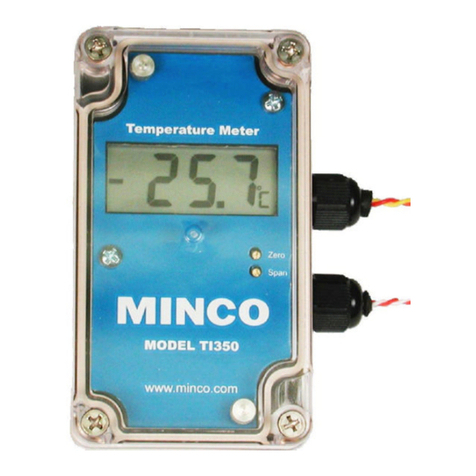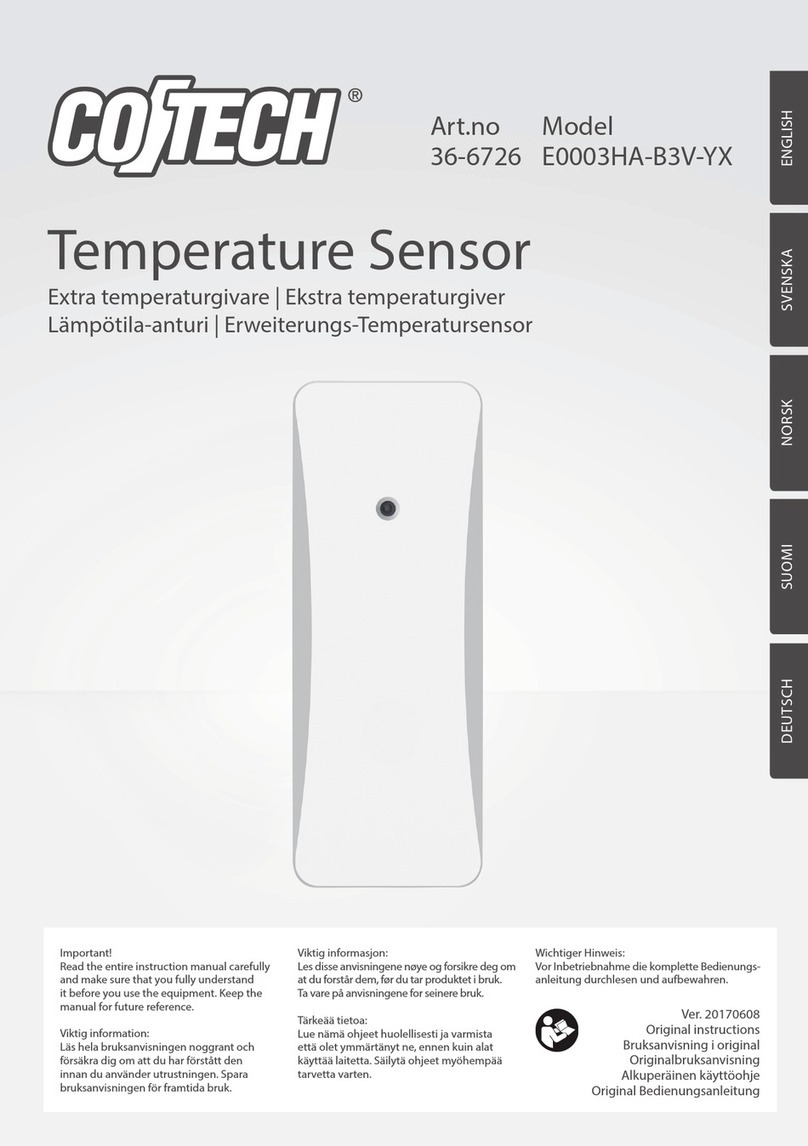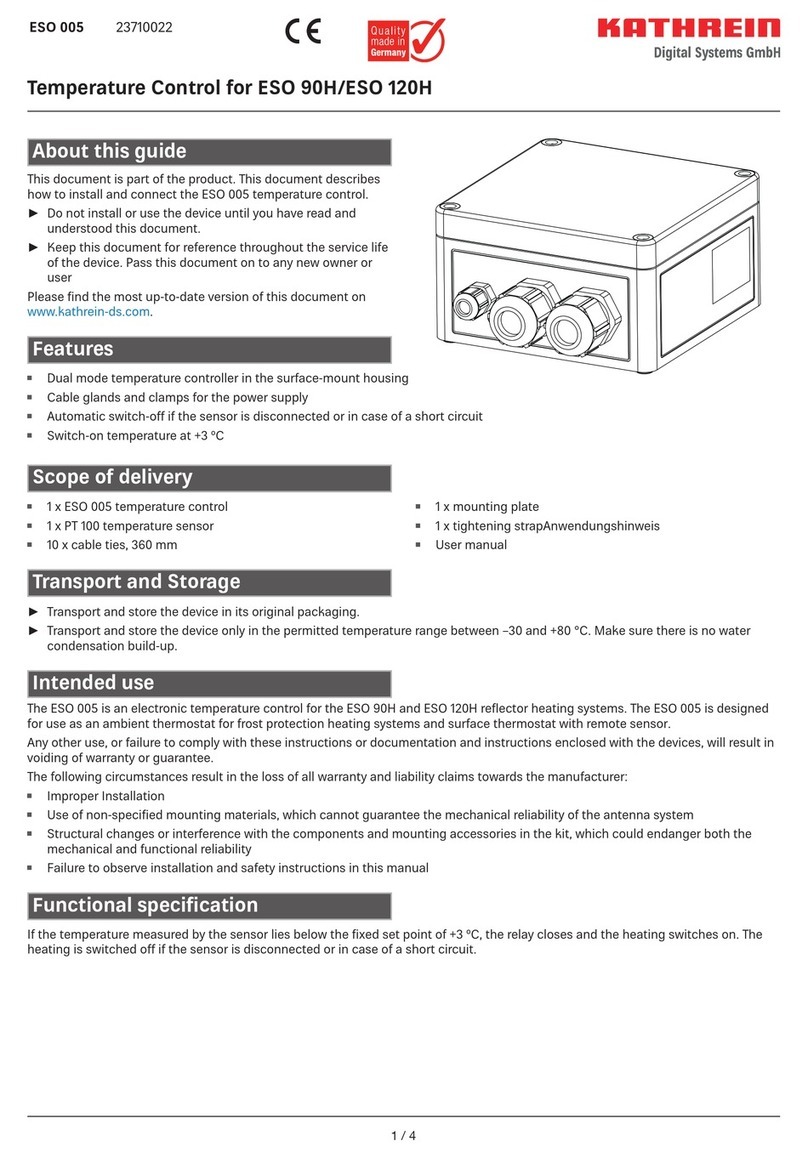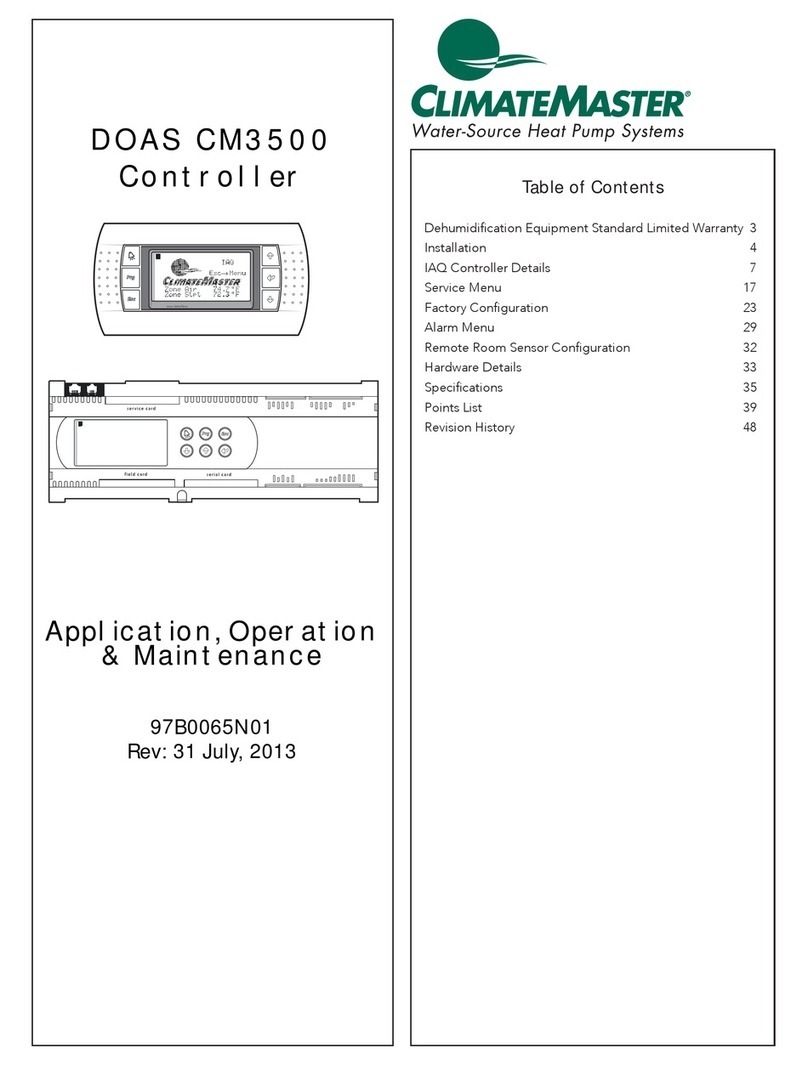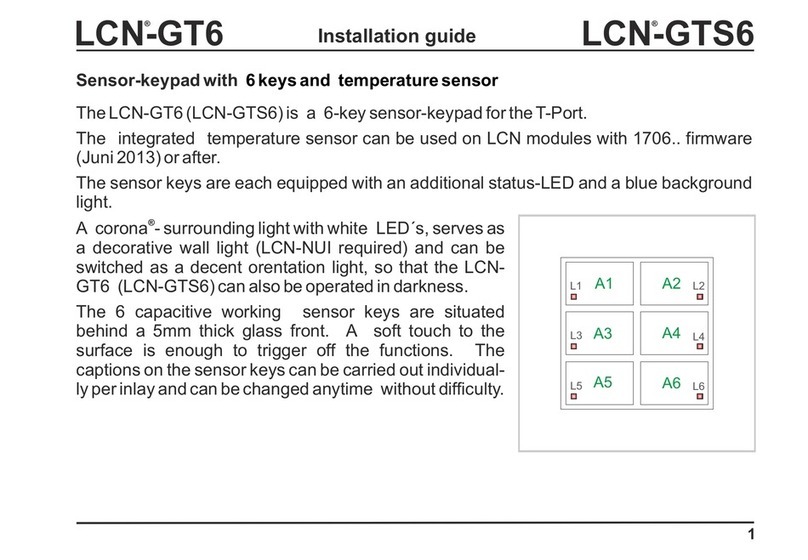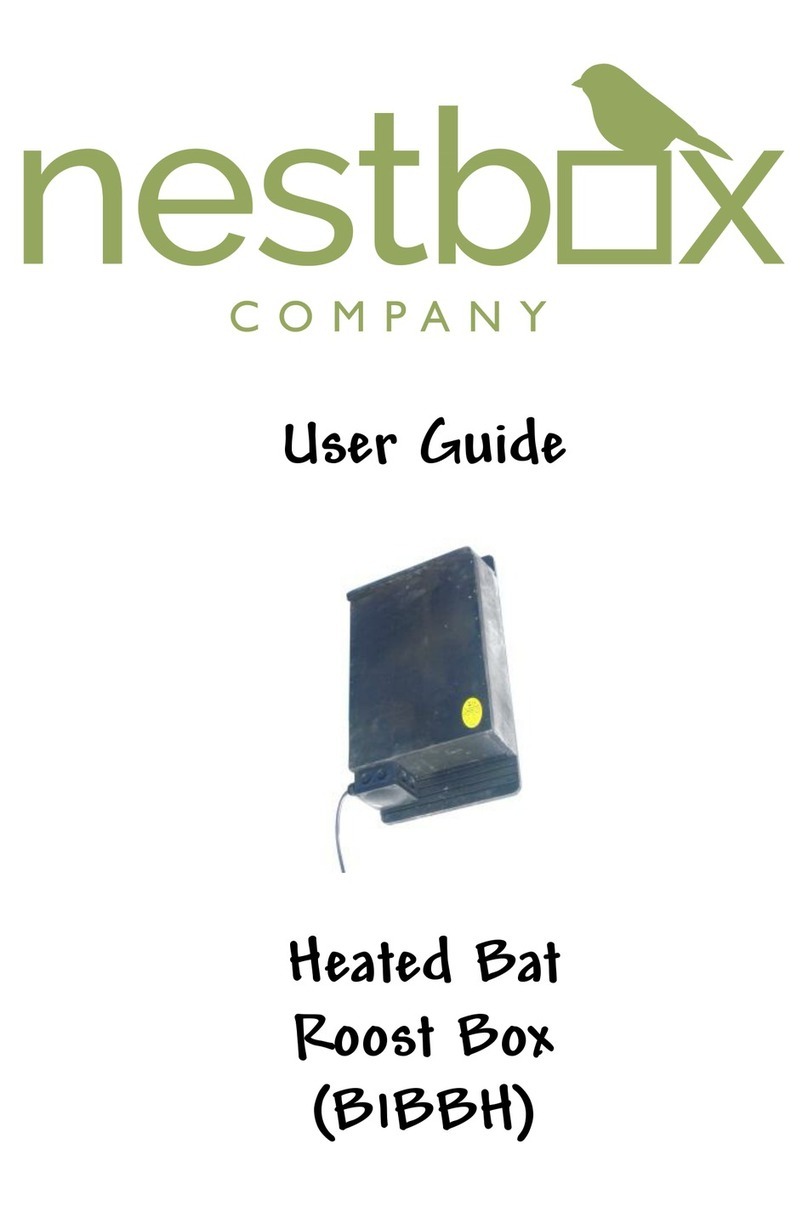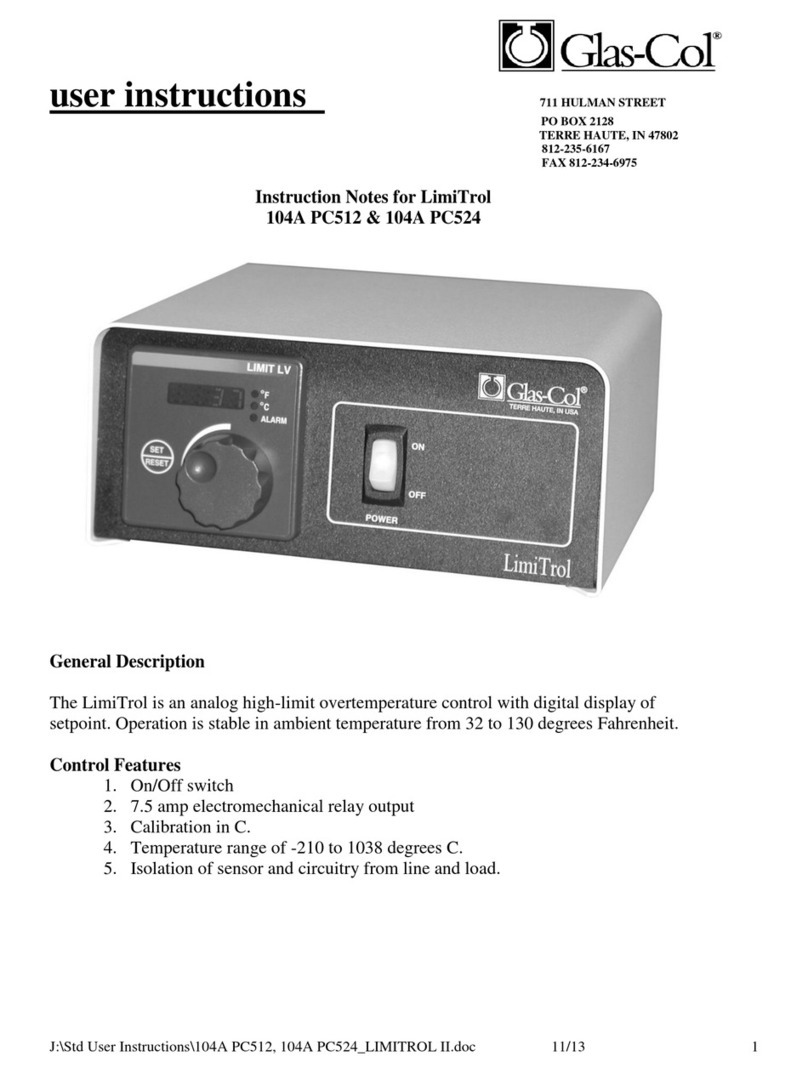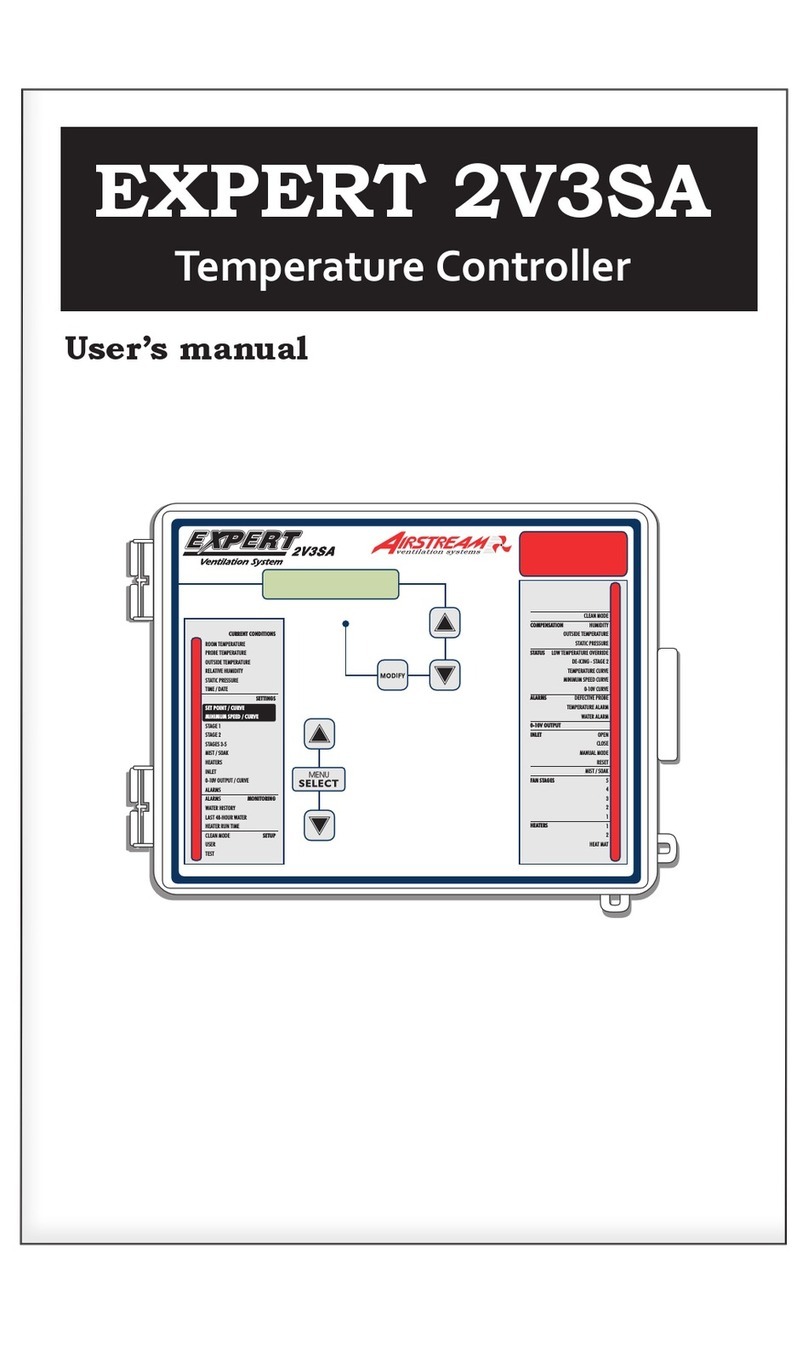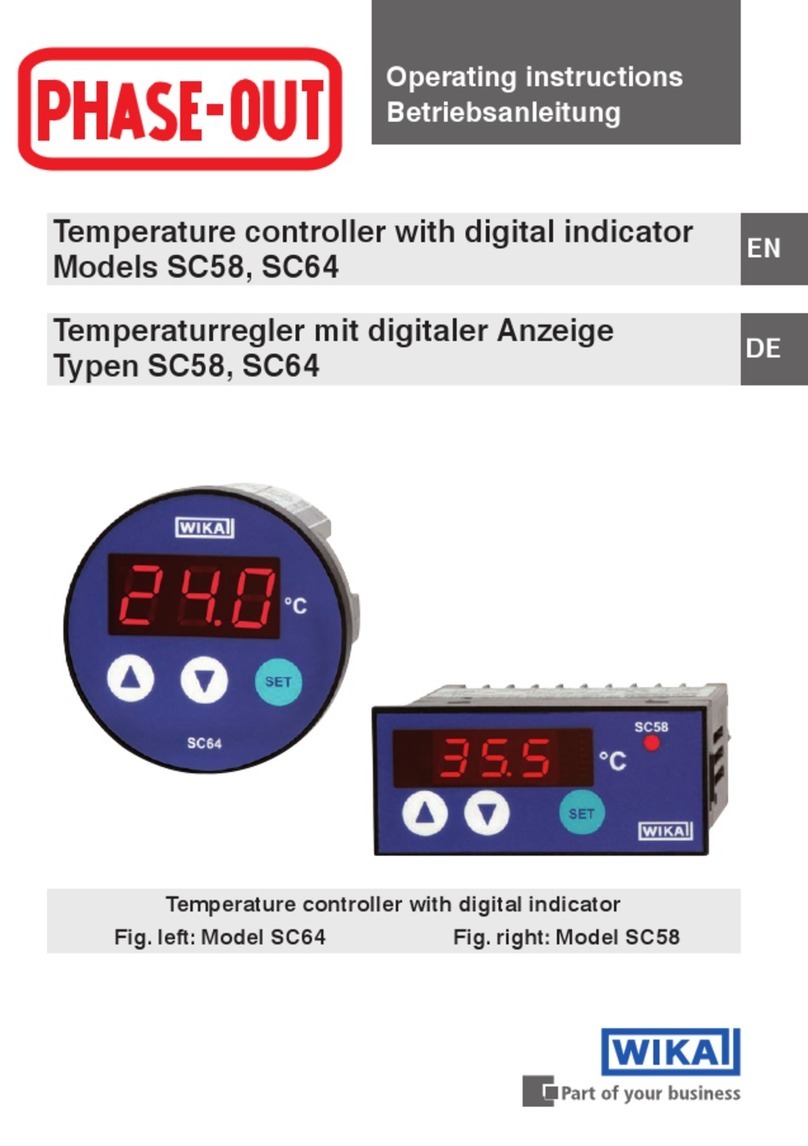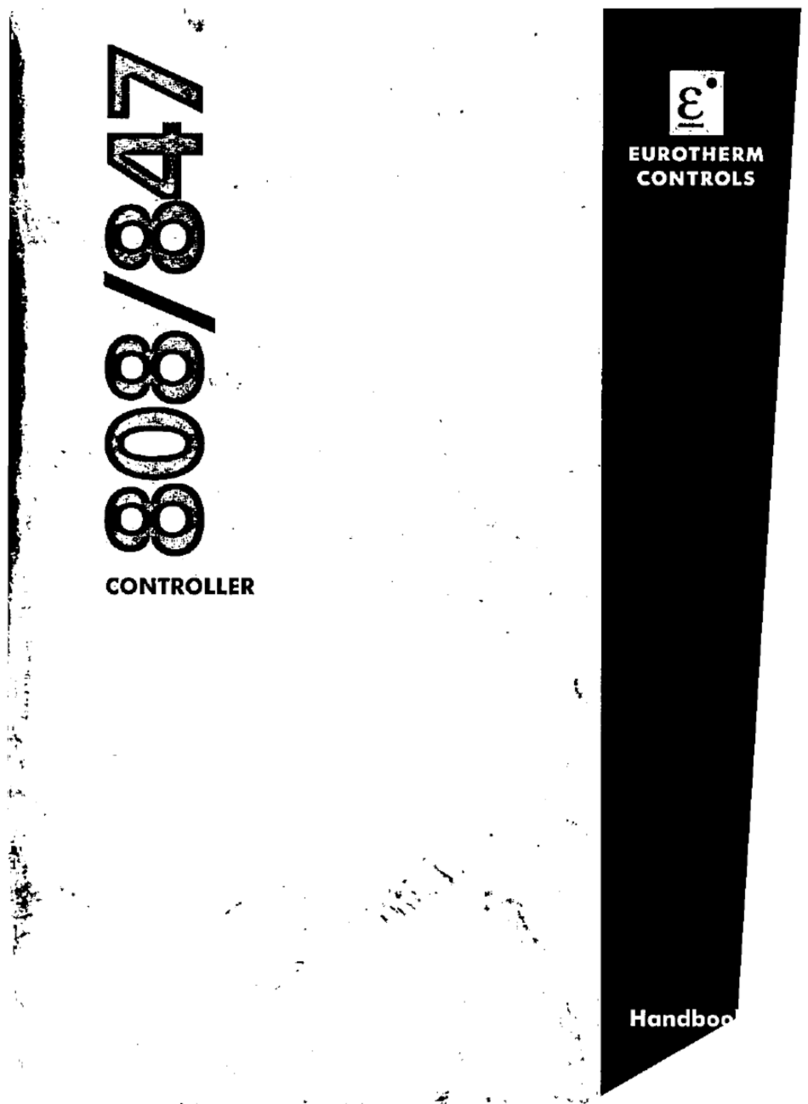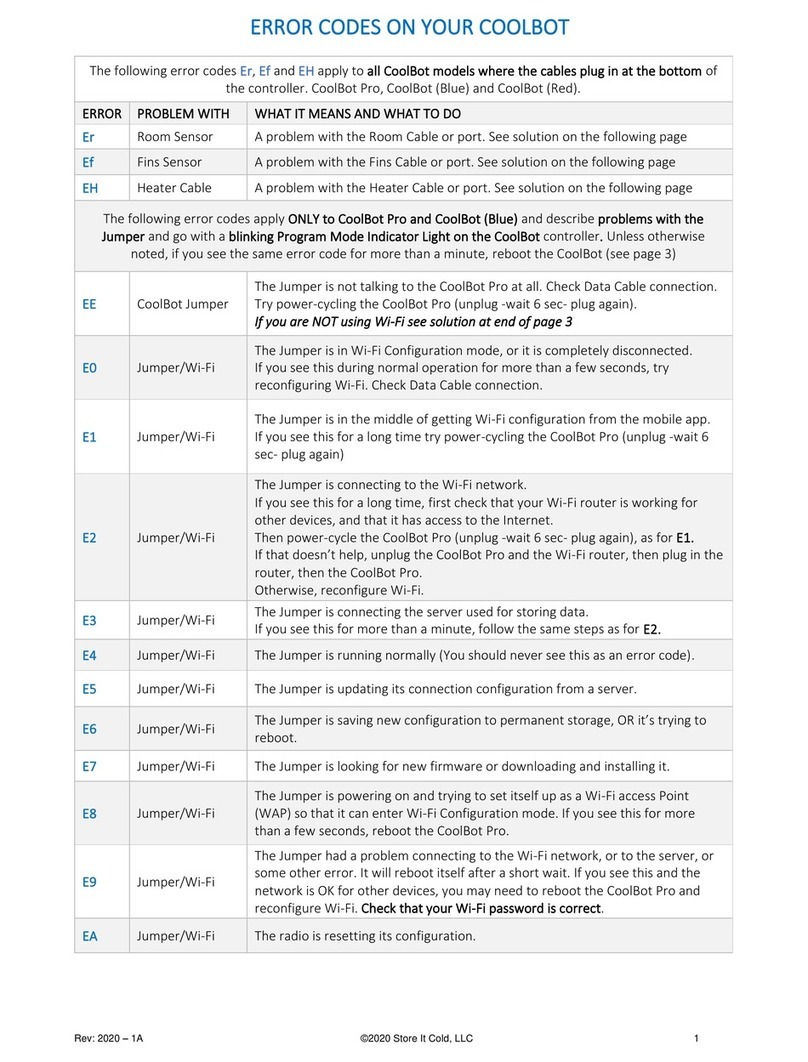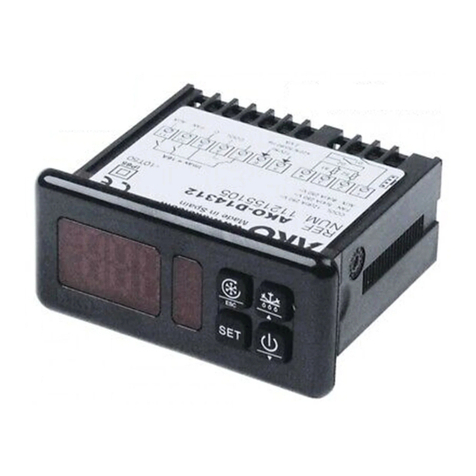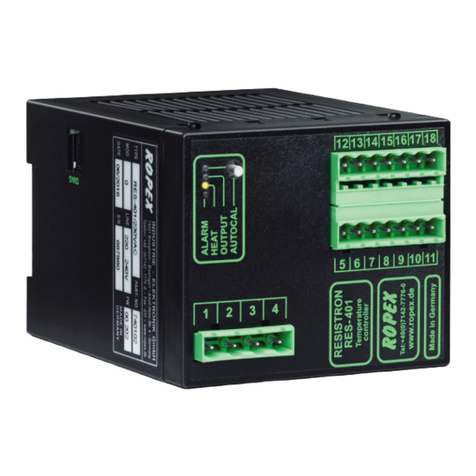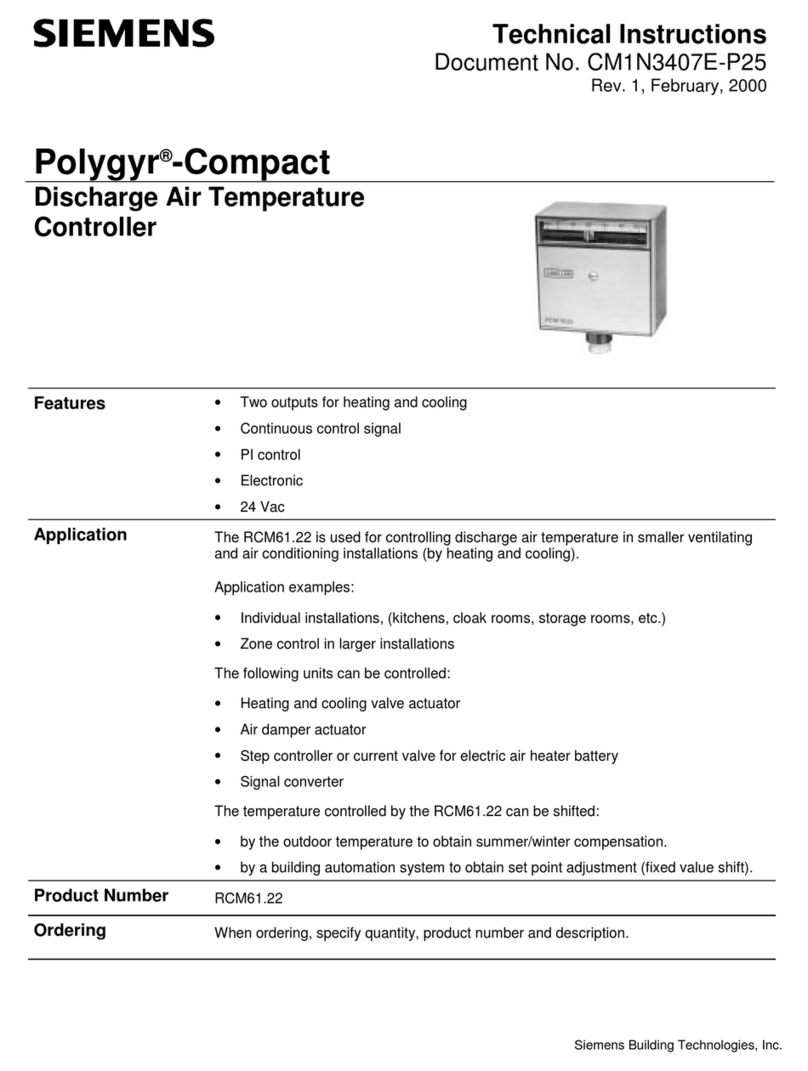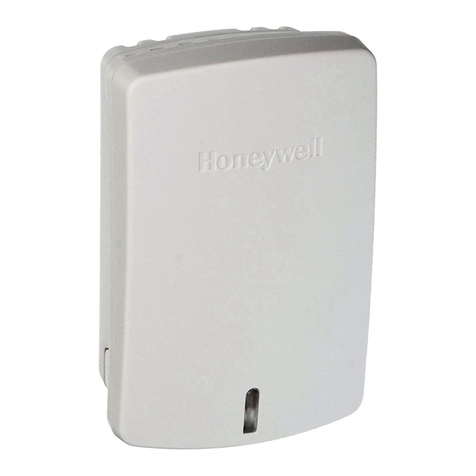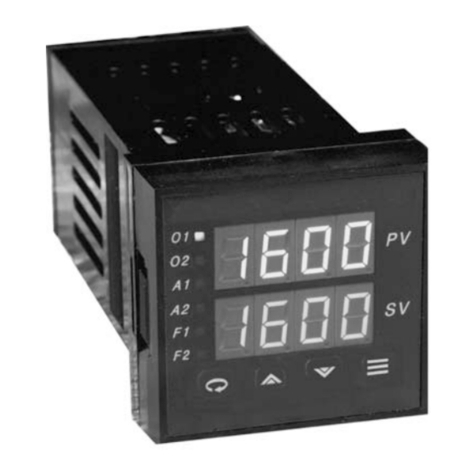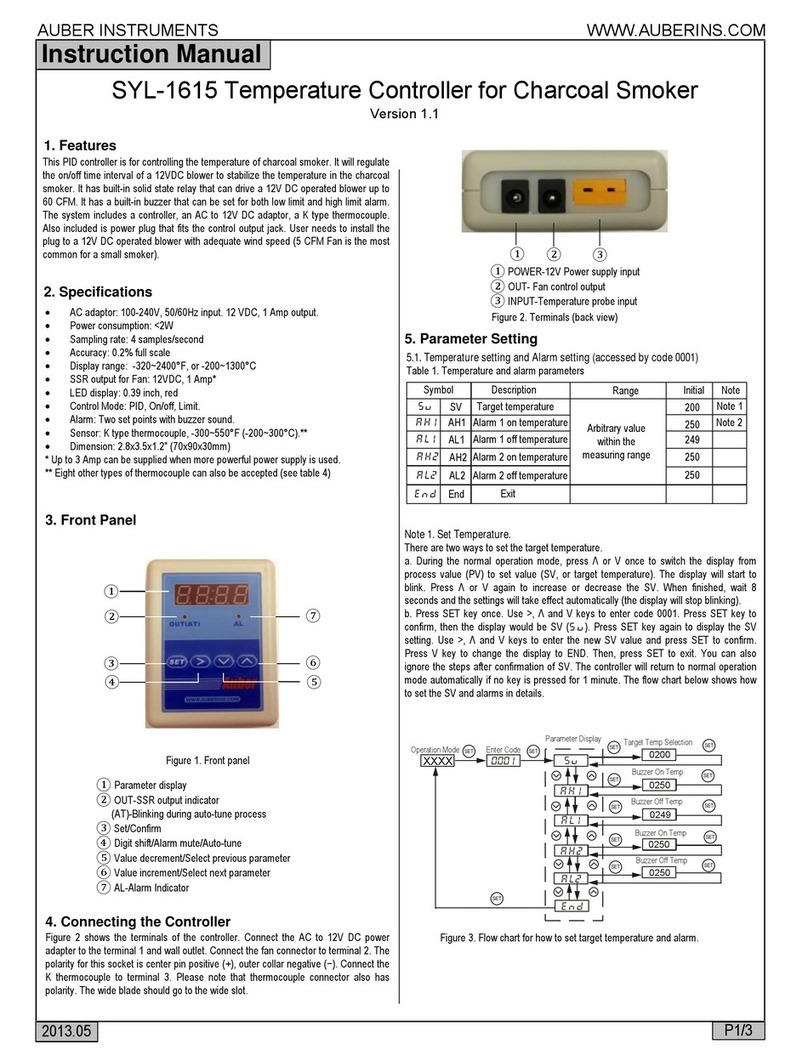Minco CT15 Series User manual

1
INSTRUCTIONS FOR THE CT15 SERIES
MICROPROCESSOR BASED
TEMPERATURE CONTROLLER
MODELIDENTIFICATION
Alarm
0 = No
1 = Yes
Input
1=Thermocouple, J, K, T
2=100Ω Platinum RTD
(DIN), element PD
Model CT15
Output
1=SSR
2=5 VDC
3=Relay
Page 12 of 12
LIMITED WARRANTY
Minco Products, Inc. warrants to the Buyer that any equipment sold will be free from
defects in material or workmanship. If, at any time within thirtysix (36) months after
shipment of CT15 Series Controls or within three (3) months after shipment of other
assembliesorparts,theSellerisnotifiedofsuchdefectandthedefectiveitemisreturned
to Seller by Buyer, transportation prepaid, for examination, the Seller will, at his option,
either repair or replace the defective items.
Thiswarrantyshallbeeffectiveonlyifinstallationandmaintenanceisinaccordancewith
Seller's instructions and the defect is not caused by shipping damage, misuse or abuse
by the Buyer. There are no other warranties, written, oral, or implied. The liability of the
Seller is limited to the repair or replacement of the defective item as set forth above.
Itemswhichwearorareperishable bymisusearenotwarranted. Theseinclude, butare
not limited to, relays, contact points, lamps, LEDs, load SCRs, SSRs, and triacs.
(All dimensions in mm with inches in parentheses.)
Panel cutout for all models 45 mm X 45 mm (1.775" X 1.775"). Allow for
13 mm (0.5") clearance at the rear of instrument.
*Present for SSR and 5 VDC output.
G:\MOD\CT15\LIT\759MN.PM5
7/03
360-00066
© 1994, MINCO PRODUCTS, INC. ALL RIGHTS RESERVED. NO PORTION MAY BE COPIED WITHOUT THE
EXPRESS WRITTEN CONSENT OF MINCO PRODUCTS, INC.
DIMENSIONS

Page 2 of 12
TABLE OF CONTENTS
INPUTWIRING .......................................................................................................................3
INSTALLATION.......................................................................................................................3
WIRING ...................................................................................................................................4
FRONT PANEL KEY FUNCTIONS..........................................................................................4
SECURITYLEVELSELECTION .............................................................................................5
MENU SELECTIONS .............................................................................................................6
PRIMARYMENU.....................................................................................................................6
SECONDARYMENU ..............................................................................................................6
SECUREMENU ......................................................................................................................7
ALARM TYPE AND ACTION...................................................................................................8
DIAGNOSTICERRORMESSAGES .....................................................................................10
SPECIFICATIONS.................................................................................................................11
DIMENSIONS........................................................................................................................12
GETTING STARTED
1. Installthe controlas describedon page3.
2. Wireyourcontrol followingtheinstructionson page3and drawingonpage4.
3. Mostcontrolsdonotneedmany(ifany)programchangestoworkonyourprocess. Forbest
results if programming changes are necessary, make all the necessary changes in the
SECUREMENU(page7)beforemakingchangestotheSECONDARYMENU(page6). If
errormessagesoccur,checktheDiagnosticErrorMessagesonpage10forhelp.
Take the example of a Model CT15011 that comes from the factory programmed for type J
thermocouples. SupposeforthisexampleyouwishtochangetheinputtotypeKandlimitthe
setpointrangebetween0° and1000°C.
First,entertheSECUREMENUasinstructedonpage7. PresstheINDEXkeyuntilthedisplay
shows
Inp
andpresstheDOWNARROWuntilthedisplayshows
CA
. Don'tforgettopressthe
ENTERkey toretainyour setting.
Next,presstheINDEXkeytodisplay
F-C
. PresstheDOWNARROWuntilthedisplayshows
C
.
PressENTER.
Next,presstheINDEXkeyuntil
SPL
isdisplayed(passthe
dPt
and
InPt
selections). Pressthe
UP ARROW until the display shows
0
. PressENTER.
Finally, press INDEX key to display
SPH
. Press the DOWN ARROW until the display shows
1000
. PressENTER.
Thenecessary program changes are now complete. After 30 seconds thedisplay will switch
backtothetemperaturereading. Ifyouwanttoreturnfaster,presstheUPARROWandENTER
keys(atthesametime)andthenpresstheDOWNARROWandINDEXkeys(againatthesame
time). Thiswill'back out'ofthemenu andimmediatelydisplay thetemperaturereading.
Page 11 of 12
Input Type
-
Temperature
Range & Unit
of measure
1°F
1°C
Type J
Iron-
Constantan
-100 to +1600
-73 to +871
Type K
Chromel-
Alumel
-200 to +2500
-129 to +1371
Type T
Copper-
Constantan
-350 to +750
-212 to +398
Input Ranges (as ordered)
ThermocoupleTypes
SPECIFICATIONS
Selectable Inputs: Thermocouple or RTD as ordered.
Input Impedance:
Thermocouple = 3 megohms minimum. RTD current = 200 uA.
Sensor Break Protection: De-energizes control output to protect system.
Set Point Range: Selectable (See range chart above).
Display: One; 4 digit, 7 segment, 0.3" high LEDs.
Control Action: Selectable for Reverse (usually heating) or Direct (usually cooling).
Ramp: One ramp time adjustable from 0 to 100 hours.
Proportional Band: 5 to 5000 °F or equivalent °C.
ResetTime (Integral): Off or 0.1 to 99.9 minutes.
RateTime (Derivative): Off or 0.01 to 99.99 minutes.
Cycle Rate: 1 to 80 seconds, and on-off.
On - Off Differential: Adjustable 1° F to 999°F in 1° steps (equivalent °C).
Alarm On - Off Differential: 2° F or equivalent in °C.
Accuracy: ±0.25% of span, ±1 degree.
Resolution: 1 degree or 0.1 degree, selectable.
LineVoltage Stability: ±0.05% over the supply voltage range.
Temperature Stability: 4µV/°C (2.3 µV/°F) typical, 8 µV/°C (4.5 µV°F) maximum.
Common Mode Rejection: 140 db minimum at 60 Hz.
Normal Mode Rejection: 65 db typical, 60 db at 60 Hz.
Isolation: Relay and SSR outputs are isolated. 5VDC output must not share a common
ground with the input.
SupplyVoltage:100to240VAC,nom.,+10-15%,50to400Hz.singlephase;132to240
VDC, nom., +10 -20%.
Power Consumption: 5VA maximum.
OperatingTemperature Range: -10 to +55 °C (+14 to 131 °F).
StorageTemperature Range: -40 to +80 °C (-40 to 176 °F).
Operating Humidity Range: 0 to 90% up to 40 °C non-condensing. 10 to 50% at 55 °C
non-condensing.
Memory Backup: Non-volatile memory. No batteries required.
Control Output Ratings:
1. SSR, 3.5 A @ 250 VAC at 25 °C. Derates to 1.25 A @ 55 °C. Minimum 48 VAC and
100 mA required.
2. Switched voltage (non-isolated): 5 VDC @ 25 mA.
3.Relay,FormAcontact(SPST),3A@250VACresistive;1.5A@250VACinductive;
Pilot Duty Rating: 250 VA, 2 A @ 125 VAC or 1 A @ 250 VAC.
Alarm Relay Rating: Same as Control Output Relay.
Weight: 227 g (8 oz).
Agency Approvals: UL E83725, and CSA LR40125.
Front Panel Rating (non-hazardous locations): Designed to meet UL 4X for non-
hazardous locations (equal to NEMA rating).
100 Ohm Platinum
0.00385 DIN Curve
element code PD
-328 to +1607
-200 to +875
RTDType

Page 3 of 12
INSTALLATION
Mounttheinstrumentinalocationthatwillnotbesubjecttoexcessivetemperature,shock,
or vibration. All models are designed for mounting in an
enclosedpanel.
Selectthepositiondesiredfortheinstrument onthepanel.
If more than one instrument is required, only two units can
bemountedcloselytogether,eitheroneabovetheotheror
sideby side. When mounted together,the mounting collar
will require modification by removing the inside tab from
each collar.
Prepare the panel by cutting
and deburring the required
opening.
From the front of the panel,
slide the housing through the
cut out. The housing gasket
shouldbe againstthehousing
flange before installing.
From the rear of the panel slide
themountingcollaroverthehous-
ing. Hold the housing with one
hand and using the other hand,
pushthecollarevenlyagainstthe
panel until the spring loops are
slightly compressed. The ratch-
ets will hold the mounting collar
and housing in place.
INPUTWIRING
Donotrunthermocoupleorotherinputwiringinthesameconduitaspowerleads. Useonlythetype
of thermocouple or RTD probe for which the control has been programmed. See the "
SECURE
MENU
" to change between RTD and thermocouple input types.
For thermocouple input always use extension leads of the same type designated for your thermo-
couple.
Page 10 of 12
DIAGNOSTIC ERROR MESSAGES
ACTION REQUIRED
Input signals may normally go above
or below range ends. If not, check
input and correct.
To reset use the
INDEX
&
ENTER
keys. When
InPt
(input fault timer)
has been set for a time, the outputs
will be turned off after the set time.
Setting the time to OFF causes the
outputs to remain active, however
UFL
or
OFL
will still be displayed.
Correct or replace sensor. To reset
use the
INDEX
&
ENTER
keys.
Remove the instrument for service
and/orrecalibration. Toresetusethe
INDEX
&
ENTER
keys.
Remove the instrument for service
and/orrecalibration. Toresetusethe
INDEX
&
ENTER
keys.
Checkthat thepowersupply ison, or
that the external fuses are good.
Thedisplayalternatesbetween
FAIL
tESt
and one of the following mes-
sages:
FACt dFLt
: Memory may be
corrupted. Pressthe
ENTER
keyand
the
DOWN ARROW
key to start the
factory default procedure. Re-check
controller programming.
rEt FACt
:
Can not recover from error, return to
factory for service.
Correct the
SP
or adjust the
SPL
or
SPH
values by programming new
values.
Correct the
SPL
or
SPH
values by
programming new values.
DISPLAY
UFL
or
OFL
bAd
InP
OPEn
InP
CHEC
CAL
No dis-
play
lighted
FAIL
tESt
CHEC SP
CHEC ALLO
CHEC ALHi
CHEC
SPL
or
CHEC
SPH
MEANING
Underflow or Overflow:
Process value has ex-
ceeded input range ends.
UFL
or
OFL
willsequence
to display one of these
messagesifthe
InPt
isset
for a time value.
For RTD inputs RTD is
open or shorted.
ForTHERMOCOUPLEin-
putsthermocoupleisopen.
Checkcalibrationappears
asanalternatingmessage
if the instrument calibra-
tionnearstoleranceedges.
Checkcalibrationappears
as a flashing message if
the instrument calibration
exceeds specification.
Display is blank. Instru-
ment may not be getting
power, or the supply volt-
age is too low.
Fail test appears upon
power up if the internal di-
agnostics detect a failure.
This message may occur
duringoperationifafailure
isdetected. Displaysflash.
This message will appear
upon power up if the set
point is set outside of the
SPL
or
SPH
values.
This message appears at
power up if
SPL
or
SPH
values are programmed
outside the input range
ends.
SP OUTPUTS
Set point output
active
Alarms active
Set point output
inactive
Alarms active
Set point output
active
Alarms active
Set point output
inactive
Alarms active
Set point output
inactive
Alarms inactive
Set point output
inactive
Alarms inactive
Set point output
inactive
Alarms active
Set point output
inactive
Alarms inactive

Page 4 of 12
FRONT PANEL KEY FUNCTIONS
Set Point Lamp
Alarm Lamp
°F Indicator*
°C Indicator* Decimal point
flashes while
*Lamp flashes during ramping function
Self-Tuneoperation. is active.
The1500Seriescontrolshaveonedisplay. Thedisplaymustoccasionallyswitchtoshow
a complete message or menu item and its value. The normal display shows just the
temperature and does not switch. While showing a menu item, the display will alternate
betweenthemenuitemandtheitemvalue. IftheUParrow,DOWNarrow,orENTERkeys
are pressed, the display immediately switches to display the item value.
Key functions are as follows:
1. INDEX: Pressing the INDEX key advances the display to the next menu item. May
also be used in conjunction with other keys as noted below.
2UP ARROW:Increments a value, changes a menu item, or selects the item to ON.
The maximum value obtainable is 9999 or 999.9.
3. DOWN ARROW:Decrements a value,changes a menu item, or selects the item to
OFF. The minimum value obtainable is -1999 or -199.9.
4. ENTER: Pressing ENTER stores the value or the item changed. If not pressed, the
previously stored value or item will be retained. The display will flash once when
ENTER is pressed.
5. UP ARROW & ENTER: Pressing these keys simultaneously brings up the
SECONDARY MENU starting at the alarm, tune, or cycle item (depending on
programming). Pressing these keys for 5 seconds will bring up the SECURE MENU.
WIRING
Page 9 of 12
The following menu items apply only to the alarm.
AL Alarms: Select OFF, Lo, Hi, or HiLo.
OFF AlarmsareturnedOFF.NoAlarmmenuitemsappearintheSecondaryand
Secure menus.
Lo Low Alarm Only. ALLo appears in the Secondary Menu.
Hi High Alarm Only. ALHi appears in the Secondary Menu.
HiLo High and Low Alarms. Both share the same Alarm Relay output.
ALt Alarm Type: Select AbS or dE
AbS AbsoluteAlarmthatmaybesetanywherewithinthevaluesofSPLandSPH
and is independent of SP.
dE DeviationAlarmthatmaybesetasanoffsetfromSP. AsSPischangedthe
Alarm Point will track with SP.
ALrE Alarm Reset: Select OnOF or Hold.
OnOF Automatic Reset.
Hold ManualReset.Acknowledge(reset)bysimultaneouslypressingtheINDEX
& DOWN ARROW keys for 5 sec.
ALPi Alarm Power Interrupt: Select On or OFF.
On Alarm Power Interrupt is ON.
OFF Alarm Power Interrupt is OFF.
ALiH Alarm Inhibit: Select On or OFF.
On Alarm Inhibit is ON. Alarm action is suspended until the process value first
enters a non-alarm condition.
OFF Alarm Inhibit is OFF.
ALSt Alarm Output State: Select CLOS or OPEn.
CLOS Closes Contacts at Alarm Set Point.
OPEn Opens Contacts at Alarm Set Point.
ALLP Alarm Lamp: Select O on or OoFF.
O on Alarm Lamp is ON when alarm contact is closed.
OoFF Alarm Lamp is OFF when alarm contact is closed.
D = deviation

Page 5 of 12
6.INDEX&DOWNARROW:Pressingthesekeyssimultaneouslywillallowbackingup
one menu item, or if at the first menu item they will cause the display to return to the
PRIMARYMENU. Ifanalarmconditionhasoccurred,thesekeysmaybeusedtoreset
the alarm.
7. INDEX &ENTER:Pressing these keys simultaneously and holding them for 5
secondsallowsrecoveryfrom thevariouserrormessages. Thefollowing menuitems
will be reset:
ALiH: Alarm inhibit OPEn InP: Thermocouple error message
bAd InP: RTD error message CHECCAL:Checkcalibrationerrormessage
Correct the problems associated with the above conditions first before using these reset
keys. More than one error could be present. Caution is advised since several items are
reset at one time.
While in the PRIMARYor SECONDARY MENU,if no key is pressed for a period of 30
seconds,thedisplaywillreturntotheHOMEpositiondisplayingthetemperaturevalue.The
time is increased to 1 minute when in the SECURE MENU.
NOTE: To move to the PRIMARY MENU quickly from any other menu, press the UP
ARROW &ENTER keys followed by pressing the INDEX & DOWN ARROW keys.
SECURITY LEVEL SELECTION
NOTE: Lock menus to prevent unauthorized changes to controller settings.
Fourlevelsof security areprovided.The securitylevelcanbe changedunderSECr in the
SECUREMENU. Thedisplayshowsthecurrentsecuritylevel. Refertothepasswordtable
belowforthecorrectvaluetoenterforthesecurityleveldesired. Tochangesecuritylevels,
set the password value using the UP & DOWN ARROW keys and press the ENTER key.
TheSECr menuitem'ssecurity levelmaybeviewedorchangedat anytimeregardlessof
the present security level. The password values shown in the table cannot be altered, so
retain a copy of this page for future reference. This will be the only reference made to
password values in this instruction book.
PASSWORD TABLE
DISPLAYEDVALUE
WHEN VIEWED
1
2
3
4
SECURITY LEVEL
MENU SECURITY
Primary Locked
Secondary Locked
Secure Locked
Primary Unlocked
Secondary Locked
Secure Locked
Primary Unlocked
Secondary Unlocked
Secure Locked
Primary Unlocked
Secondary Unlocked
Secure Unlocked
PASSWORD
VALUE TO ENTER
1110
1101
1011
111
Page 8 of 12
InPt Input Fault Timer: Select OFF, 0.1 to 540.0 minutes. Whenever an Input is out of
range(UFL or OFLdisplayed), shorted,or open thetimer willstart. When thetime
has elapsed, the controller will revert to a safe condition (Output Off, Flashing
Display). If OFF is selected, the Input Fault Timer will not be recognized (time =
infinite).
SPL Set Point Low: Select from the lowest input range value to SPH value.This willset
theminimumSP valuethatcanbeentered.ThevalueforSPwillstopmovingwhen
this value is reached.
SPH SetPointHigh:SelectfromthehighestinputrangevaluetoSPLvalue.Thiswillset
themaximumSPvaluethatcanbeentered.ThevalueforSPwillstopmovingwhen
this value is reached.
SPSt Set Point State: Select dir or rE.
dir Direct Action. As the input increases the output will increase. Most com-
monly used in cooling processes.
rE Reverse Action. As the input increases the output will decrease. Most
commonly used in heating processes.
SPOL SetPointOutputLowLimit:Select0to100%butnotgreaterthanSPOH.Thisitem
limitsthe lowest output value. Thisis useful foradding a biasto the process when
needed.
SPOH Set Point Output High Limit: Select 0to 100% but not less than SPOL. This item
allowssettingthemaximumoutputlimit.Thisisusefulwithprocessesthatareover-
powered.
SPLP Set Point Lamp: Select O on or OoFF.
O on Lamp ON when Output is ON.
OoFF Lamp OFF when Output is ON.
ALARMTYPE AND ACTION (if present)
Caution: In any critical application where failure could cause expensive
product loss or endanger personal safety, a redundant limit controller is
required.
When setting an alarm value for an absolute alarm (ALt = AbS), simply set the value at
which the alarm is to occur.
When setting the alarm value for a deviation alarm (ALt = dE), set the difference in value
from the Set Point (SP) desired. For example, if a low alarm is required to be 5 degrees
belowtheSP,thensetALLoto-5.Ifahighalarmisrequired20degreesabovetheSP,then
setALHi to+20.IfSPis changed, thealarmwillcontinuetoholdthesamerelationshipas
originally set.
The diagram at the top of the next page shows the action and reset functions for both
absolute and deviation alarms.
When Alarm Power Interrupt, ALPi, is programmed ON and Alarm Reset, ALrE, is
programmed for Hold, the alarm will automatically reset upon a power failure and
subsequent restoration if no alarm condition is present.
IfAlarmInhibit,ALiH,isselectedON,analarmconditionissuspendeduponpowerupuntil
theprocess value passes through thealarm set point once.Alarm inhibit can be restored
as if a power up took place by pressing both the INDEX and ENTER keys for 5 seconds.
Warning:Resetting a high alarm inhibit will not cause an alarm to occur
if the Process Value does not first drop below the high alarm setting. Do
not use the Alarm Inhibit feature if a hazard is created by this action. Be
suretotestallcombinationsofhighand low alarm inhibit actions before
placing control into operation.

Page 6 of 12
MENU SELECTIONS
PRIMARY MENU
Press INDEX to advance to the next menu item. Press UP ARROW or DOWN ARROW
to change the value in the display. Press ENTER to retain the value.
SP Set Point Adjust, Control Point.
SECONDARY MENU
Press UP ARROW &ENTER simultaneously.PressINDEX to advanceto the nextmenu
item. Press UP ARROW or DOWN ARROW to change the value in the display. Press
ENTER to retain the value.
ALLo Alarm Low: The Low Alarm point is usually set below the Set Point.
ALHi Alarm High: The High Alarm Point is usually set above the Set Point.
CY CycleRate andoutput selection:Select OnOF, 1, 2 to80 secondstotal cycletime.
ONOF A setting of ONOF allows the control to operate as a simple on/off mode.
Thissettingforcesthecontroltoturnoffatsetpoint,andonatthesetpoint
plus the differential (SP_d). When selected, the tunE, Pb, rES, OFS, rtE,
and ArUP selections in the Secondary menu and the SPOL and SPOH
selections in the Secure menu are suppressed.
1A setting of 1 is recommended for solid state outputs (SSR or 5VDC).
2 to 80TimeProportioningControlisadjustablein1sec.steps.Recommendedfor
mechanical outputs (relays, solenoids, etc.). For best contact life, a time
shouldbe selected thatis aslong as possiblewithout causingthe process
to wander.
SP_d SetPointOn-OffDifferential. (OnlyappearsifCYissettoONOF.)Select1to999°F.
Thisvaluewillbenegativeforreverseactingsetpoints,andpositivefordirectacting
outputs. Set the value for the amount of temperature difference between the turn
off point (set point) and the turn on point.
tunE Tuning Choice: Select SELF or Pid.
SELF The Controller will evaluate the Process and select the PID values to
maintain good control. The ramp function (rt) cannot be selected while
SELFtunEisactive. ThetemperaturedescriptorwillflashwhileSELFtunE
is active. The control will switch to Pid tunE when the tuning function is
complete.
Pid Manually adjust the PID values. PID control consists of three basic
parameters, Proportional Band (Gain), Reset Time (Integral), and Rate
Time (Derivative).
Pb Proportional Band (Bandwidth): Select 5to 5000 °F(3to 2778 °C).
rES AutomaticResetTime:SelectOFF,0.1to99.9minutes.SelectOFF
to switch to OFS.
OFS Manual Offset Correction: Select OFF, 0.1 to 99.9%. Select OFF to
switch to rES.
rtE Rate Time. Select OFF, 0.01 to 99.99 minutes (Derivative).
Page 7 of 12
ArUP Anti- Reset Wind-up Feature: Select On or OFF.
On If ArUP is On the accumulated Reset Offset value will be cleared to 0%
when the process input is not within the Proportional Band.
OFF IfArUP isOFF,theaccumulatedResetOffsetValueisretainedinmemory
when the process input is not within the Proportional Band.
rt RampTime: SelectOFF,00.01to99.59(HH.MM). Whenvalueisentered,control
calculatesarampslope fromthecurrenttemperatureto SPoverthetimeentered.
Changing rt or SP (or pressing ENTER at either menu item) restarts the ramp
function, and re-calculates the slope. The right hand decimal point of the display
willflash while the rampfunction is active. Self tunE cannotbe selectedwhile the
rampfunctionisactive. SelectingOFFwillstopacurrentrampanddrivetheoutput
as necessary to reach set point
InPC Input Correction: Select ±500 °F(±278 °C). This feature allows the input value to
bechangedtoagreewithanexternalreferenceortocompensateforsensorerror.
Note: InPC is reset to zero when the input type is changed, or when decimal
position is changed.
FiLt Digital Filter: Select OFF,1 to 99. In some cases the time constant of the sensor,
or noise could cause the display to jump enough to be unreadable. A setting of 2
is usually sufficient to provide enough filtering for most cases, (2 represents
approximately a 1 second time constant). When the 0.1 degree resolution is
selected this should be increased to 4. If this value is set too high, controllability
will suffer.
SECURE MENU
HoldUPARROW&ENTERfor5Seconds. PressINDEXtoadvancetothenextmenuitem.
Press UP ARROW or DOWN ARROW to changethe value in the display. Press ENTER
to retain the value.
SECr Security Code: See the Security Level Selection and the Password Table in this
manual in order to enter the correct password.
InP InputType: Select one of the following. The selections are limited to the input type
youordered. Ifyouorderedathermocoupleinputcontrol,makeyourselectionfrom
the thermocouple list. If you ordered an RTD input, select from the RTD list.
Thermocouple selections:
J-IC Type “J” Thermocouple, Iron/Constantan (NIST)
CA Type “K” Thermocouple Chromel/Alumel
t- Type “T” Thermocouple Copper/Constantan
RTD selection:
P385 100 ohm Platinum (DIN 0.00385 Ω/Ω/°C), element code PD.
F-C Select temperature descriptor for Fahrenheit or Celsius.
F°F descriptor is On and temperature inputs will be displayed in actual
degrees Fahrenheit.
C°C descriptor is On and temperature inputs will be displayed in actual
degrees Celsius.
dPt DecimalPointPositioning:Select0or0.0.ThisonlyaffectstheProcessValue,SP,
ALLo, ALHi, and InPC.
0No decimal Point is selected.
0.0 One decimal place is selected. If the Process Value moves outside of the
decimalpointrangeends(-199.9to+999.9),theProcessValuedisplaywill
autorangetowholedegreeresolution. WhentheProcessValuereturnsto
the decimal point range, the display will autorange back to tenth degree
resolution.

Page 6 of 12
MENU SELECTIONS
PRIMARY MENU
Press INDEX to advance to the next menu item. Press UP ARROW or DOWN ARROW
to change the value in the display. Press ENTER to retain the value.
SP Set Point Adjust, Control Point.
SECONDARY MENU
Press UP ARROW &ENTER simultaneously.PressINDEX to advanceto the nextmenu
item. Press UP ARROW or DOWN ARROW to change the value in the display. Press
ENTER to retain the value.
ALLo Alarm Low: The Low Alarm point is usually set below the Set Point.
ALHi Alarm High: The High Alarm Point is usually set above the Set Point.
CY CycleRate andoutput selection:Select OnOF, 1, 2 to80 secondstotal cycletime.
ONOF A setting of ONOF allows the control to operate as a simple on/off mode.
Thissettingforcesthecontroltoturnoffatsetpoint,andonatthesetpoint
plus the differential (SP_d). When selected, the tunE, Pb, rES, OFS, rtE,
and ArUP selections in the Secondary menu and the SPOL and SPOH
selections in the Secure menu are suppressed.
1A setting of 1 is recommended for solid state outputs (SSR or 5VDC).
2 to 80TimeProportioningControlisadjustablein1sec.steps.Recommendedfor
mechanical outputs (relays, solenoids, etc.). For best contact life, a time
shouldbe selected thatis aslong as possiblewithout causingthe process
to wander.
SP_d SetPointOn-OffDifferential. (OnlyappearsifCYissettoONOF.)Select1to999°F.
Thisvaluewillbenegativeforreverseactingsetpoints,andpositivefordirectacting
outputs. Set the value for the amount of temperature difference between the turn
off point (set point) and the turn on point.
tunE Tuning Choice: Select SELF or Pid.
SELF The Controller will evaluate the Process and select the PID values to
maintain good control. The ramp function (rt) cannot be selected while
SELFtunEisactive. ThetemperaturedescriptorwillflashwhileSELFtunE
is active. The control will switch to Pid tunE when the tuning function is
complete.
Pid Manually adjust the PID values. PID control consists of three basic
parameters, Proportional Band (Gain), Reset Time (Integral), and Rate
Time (Derivative).
Pb Proportional Band (Bandwidth): Select 5to 5000 °F(3to 2778 °C).
rES AutomaticResetTime:SelectOFF,0.1to99.9minutes.SelectOFF
to switch to OFS.
OFS Manual Offset Correction: Select OFF, 0.1 to 99.9%. Select OFF to
switch to rES.
rtE Rate Time. Select OFF, 0.01 to 99.99 minutes (Derivative).
Page 7 of 12
ArUP Anti- Reset Wind-up Feature: Select On or OFF.
On If ArUP is On the accumulated Reset Offset value will be cleared to 0%
when the process input is not within the Proportional Band.
OFF IfArUP isOFF,theaccumulatedResetOffsetValueisretainedinmemory
when the process input is not within the Proportional Band.
rt RampTime: SelectOFF,00.01to99.59(HH.MM). Whenvalueisentered,control
calculatesarampslope fromthecurrenttemperatureto SPoverthetimeentered.
Changing rt or SP (or pressing ENTER at either menu item) restarts the ramp
function, and re-calculates the slope. The right hand decimal point of the display
willflash while the rampfunction is active. Self tunE cannotbe selectedwhile the
rampfunctionisactive. SelectingOFFwillstopacurrentrampanddrivetheoutput
as necessary to reach set point
InPC Input Correction: Select ±500 °F(±278 °C). This feature allows the input value to
bechangedtoagreewithanexternalreferenceortocompensateforsensorerror.
Note: InPC is reset to zero when the input type is changed, or when decimal
position is changed.
FiLt Digital Filter: Select OFF,1 to 99. In some cases the time constant of the sensor,
or noise could cause the display to jump enough to be unreadable. A setting of 2
is usually sufficient to provide enough filtering for most cases, (2 represents
approximately a 1 second time constant). When the 0.1 degree resolution is
selected this should be increased to 4. If this value is set too high, controllability
will suffer.
SECURE MENU
HoldUPARROW&ENTERfor5Seconds. PressINDEXtoadvancetothenextmenuitem.
Press UP ARROW or DOWN ARROW to changethe value in the display. Press ENTER
to retain the value.
SECr Security Code: See the Security Level Selection and the Password Table in this
manual in order to enter the correct password.
InP InputType: Select one of the following. The selections are limited to the input type
youordered. Ifyouorderedathermocoupleinputcontrol,makeyourselectionfrom
the thermocouple list. If you ordered an RTD input, select from the RTD list.
Thermocouple selections:
J-IC Type “J” Thermocouple, Iron/Constantan (NIST)
CA Type “K” Thermocouple Chromel/Alumel
t- Type “T” Thermocouple Copper/Constantan
RTD selection:
P385 100 ohm Platinum (DIN 0.00385 Ω/Ω/°C), element code PD.
F-C Select temperature descriptor for Fahrenheit or Celsius.
F°F descriptor is On and temperature inputs will be displayed in actual
degrees Fahrenheit.
C°C descriptor is On and temperature inputs will be displayed in actual
degrees Celsius.
dPt DecimalPointPositioning:Select0or0.0.ThisonlyaffectstheProcessValue,SP,
ALLo, ALHi, and InPC.
0No decimal Point is selected.
0.0 One decimal place is selected. If the Process Value moves outside of the
decimalpointrangeends(-199.9to+999.9),theProcessValuedisplaywill
autorangetowholedegreeresolution. WhentheProcessValuereturnsto
the decimal point range, the display will autorange back to tenth degree
resolution.

Page 5 of 12
6.INDEX&DOWNARROW:Pressingthesekeyssimultaneouslywillallowbackingup
one menu item, or if at the first menu item they will cause the display to return to the
PRIMARYMENU. Ifanalarmconditionhasoccurred,thesekeysmaybeusedtoreset
the alarm.
7. INDEX &ENTER:Pressing these keys simultaneously and holding them for 5
secondsallowsrecoveryfrom thevariouserrormessages. Thefollowing menuitems
will be reset:
ALiH: Alarm inhibit OPEn InP: Thermocouple error message
bAd InP: RTD error message CHECCAL:Checkcalibrationerrormessage
Correct the problems associated with the above conditions first before using these reset
keys. More than one error could be present. Caution is advised since several items are
reset at one time.
While in the PRIMARYor SECONDARY MENU,if no key is pressed for a period of 30
seconds,thedisplaywillreturntotheHOMEpositiondisplayingthetemperaturevalue.The
time is increased to 1 minute when in the SECURE MENU.
NOTE: To move to the PRIMARY MENU quickly from any other menu, press the UP
ARROW &ENTER keys followed by pressing the INDEX & DOWN ARROW keys.
SECURITY LEVEL SELECTION
NOTE: Lock menus to prevent unauthorized changes to controller settings.
Fourlevelsof security areprovided.The securitylevelcanbe changedunderSECr in the
SECUREMENU. Thedisplayshowsthecurrentsecuritylevel. Refertothepasswordtable
belowforthecorrectvaluetoenterforthesecurityleveldesired. Tochangesecuritylevels,
set the password value using the UP & DOWN ARROW keys and press the ENTER key.
TheSECr menuitem'ssecurity levelmaybeviewedorchangedat anytimeregardlessof
the present security level. The password values shown in the table cannot be altered, so
retain a copy of this page for future reference. This will be the only reference made to
password values in this instruction book.
PASSWORD TABLE
DISPLAYEDVALUE
WHEN VIEWED
1
2
3
4
SECURITY LEVEL
MENU SECURITY
Primary Locked
Secondary Locked
Secure Locked
Primary Unlocked
Secondary Locked
Secure Locked
Primary Unlocked
Secondary Unlocked
Secure Locked
Primary Unlocked
Secondary Unlocked
Secure Unlocked
PASSWORD
VALUE TO ENTER
1110
1101
1011
111
Page 8 of 12
InPt Input Fault Timer: Select OFF, 0.1 to 540.0 minutes. Whenever an Input is out of
range(UFL or OFLdisplayed), shorted,or open thetimer willstart. When thetime
has elapsed, the controller will revert to a safe condition (Output Off, Flashing
Display). If OFF is selected, the Input Fault Timer will not be recognized (time =
infinite).
SPL Set Point Low: Select from the lowest input range value to SPH value.This willset
theminimumSP valuethatcanbeentered.ThevalueforSPwillstopmovingwhen
this value is reached.
SPH SetPointHigh:SelectfromthehighestinputrangevaluetoSPLvalue.Thiswillset
themaximumSPvaluethatcanbeentered.ThevalueforSPwillstopmovingwhen
this value is reached.
SPSt Set Point State: Select dir or rE.
dir Direct Action. As the input increases the output will increase. Most com-
monly used in cooling processes.
rE Reverse Action. As the input increases the output will decrease. Most
commonly used in heating processes.
SPOL SetPointOutputLowLimit:Select0to100%butnotgreaterthanSPOH.Thisitem
limitsthe lowest output value. Thisis useful foradding a biasto the process when
needed.
SPOH Set Point Output High Limit: Select 0to 100% but not less than SPOL. This item
allowssettingthemaximumoutputlimit.Thisisusefulwithprocessesthatareover-
powered.
SPLP Set Point Lamp: Select O on or OoFF.
O on Lamp ON when Output is ON.
OoFF Lamp OFF when Output is ON.
ALARMTYPE AND ACTION (if present)
Caution: In any critical application where failure could cause expensive
product loss or endanger personal safety, a redundant limit controller is
required.
When setting an alarm value for an absolute alarm (ALt = AbS), simply set the value at
which the alarm is to occur.
When setting the alarm value for a deviation alarm (ALt = dE), set the difference in value
from the Set Point (SP) desired. For example, if a low alarm is required to be 5 degrees
belowtheSP,thensetALLoto-5.Ifahighalarmisrequired20degreesabovetheSP,then
setALHi to+20.IfSPis changed, thealarmwillcontinuetoholdthesamerelationshipas
originally set.
The diagram at the top of the next page shows the action and reset functions for both
absolute and deviation alarms.
When Alarm Power Interrupt, ALPi, is programmed ON and Alarm Reset, ALrE, is
programmed for Hold, the alarm will automatically reset upon a power failure and
subsequent restoration if no alarm condition is present.
IfAlarmInhibit,ALiH,isselectedON,analarmconditionissuspendeduponpowerupuntil
theprocess value passes through thealarm set point once.Alarm inhibit can be restored
as if a power up took place by pressing both the INDEX and ENTER keys for 5 seconds.
Warning:Resetting a high alarm inhibit will not cause an alarm to occur
if the Process Value does not first drop below the high alarm setting. Do
not use the Alarm Inhibit feature if a hazard is created by this action. Be
suretotestallcombinationsofhighand low alarm inhibit actions before
placing control into operation.

Page 4 of 12
FRONT PANEL KEY FUNCTIONS
Set Point Lamp
Alarm Lamp
°F Indicator*
°C Indicator* Decimal point
flashes while
*Lamp flashes during ramping function
Self-Tuneoperation. is active.
The1500Seriescontrolshaveonedisplay. Thedisplaymustoccasionallyswitchtoshow
a complete message or menu item and its value. The normal display shows just the
temperature and does not switch. While showing a menu item, the display will alternate
betweenthemenuitemandtheitemvalue. IftheUParrow,DOWNarrow,orENTERkeys
are pressed, the display immediately switches to display the item value.
Key functions are as follows:
1. INDEX: Pressing the INDEX key advances the display to the next menu item. May
also be used in conjunction with other keys as noted below.
2UP ARROW:Increments a value, changes a menu item, or selects the item to ON.
The maximum value obtainable is 9999 or 999.9.
3. DOWN ARROW:Decrements a value,changes a menu item, or selects the item to
OFF. The minimum value obtainable is -1999 or -199.9.
4. ENTER: Pressing ENTER stores the value or the item changed. If not pressed, the
previously stored value or item will be retained. The display will flash once when
ENTER is pressed.
5. UP ARROW & ENTER: Pressing these keys simultaneously brings up the
SECONDARY MENU starting at the alarm, tune, or cycle item (depending on
programming). Pressing these keys for 5 seconds will bring up the SECURE MENU.
WIRING
Page 9 of 12
The following menu items apply only to the alarm.
AL Alarms: Select OFF, Lo, Hi, or HiLo.
OFF AlarmsareturnedOFF.NoAlarmmenuitemsappearintheSecondaryand
Secure menus.
Lo Low Alarm Only. ALLo appears in the Secondary Menu.
Hi High Alarm Only. ALHi appears in the Secondary Menu.
HiLo High and Low Alarms. Both share the same Alarm Relay output.
ALt Alarm Type: Select AbS or dE
AbS AbsoluteAlarmthatmaybesetanywherewithinthevaluesofSPLandSPH
and is independent of SP.
dE DeviationAlarmthatmaybesetasanoffsetfromSP. AsSPischangedthe
Alarm Point will track with SP.
ALrE Alarm Reset: Select OnOF or Hold.
OnOF Automatic Reset.
Hold ManualReset.Acknowledge(reset)bysimultaneouslypressingtheINDEX
& DOWN ARROW keys for 5 sec.
ALPi Alarm Power Interrupt: Select On or OFF.
On Alarm Power Interrupt is ON.
OFF Alarm Power Interrupt is OFF.
ALiH Alarm Inhibit: Select On or OFF.
On Alarm Inhibit is ON. Alarm action is suspended until the process value first
enters a non-alarm condition.
OFF Alarm Inhibit is OFF.
ALSt Alarm Output State: Select CLOS or OPEn.
CLOS Closes Contacts at Alarm Set Point.
OPEn Opens Contacts at Alarm Set Point.
ALLP Alarm Lamp: Select O on or OoFF.
O on Alarm Lamp is ON when alarm contact is closed.
OoFF Alarm Lamp is OFF when alarm contact is closed.
D = deviation

Page 3 of 12
INSTALLATION
Mounttheinstrumentinalocationthatwillnotbesubjecttoexcessivetemperature,shock,
or vibration. All models are designed for mounting in an
enclosedpanel.
Selectthepositiondesiredfortheinstrument onthepanel.
If more than one instrument is required, only two units can
bemountedcloselytogether,eitheroneabovetheotheror
sideby side. When mounted together,the mounting collar
will require modification by removing the inside tab from
each collar.
Prepare the panel by cutting
and deburring the required
opening.
From the front of the panel,
slide the housing through the
cut out. The housing gasket
shouldbe againstthehousing
flange before installing.
From the rear of the panel slide
themountingcollaroverthehous-
ing. Hold the housing with one
hand and using the other hand,
pushthecollarevenlyagainstthe
panel until the spring loops are
slightly compressed. The ratch-
ets will hold the mounting collar
and housing in place.
INPUTWIRING
Donotrunthermocoupleorotherinputwiringinthesameconduitaspowerleads. Useonlythetype
of thermocouple or RTD probe for which the control has been programmed. See the "
SECURE
MENU
" to change between RTD and thermocouple input types.
For thermocouple input always use extension leads of the same type designated for your thermo-
couple.
Page 10 of 12
DIAGNOSTIC ERROR MESSAGES
ACTION REQUIRED
Input signals may normally go above
or below range ends. If not, check
input and correct.
To reset use the
INDEX
&
ENTER
keys. When
InPt
(input fault timer)
has been set for a time, the outputs
will be turned off after the set time.
Setting the time to OFF causes the
outputs to remain active, however
UFL
or
OFL
will still be displayed.
Correct or replace sensor. To reset
use the
INDEX
&
ENTER
keys.
Remove the instrument for service
and/orrecalibration. Toresetusethe
INDEX
&
ENTER
keys.
Remove the instrument for service
and/orrecalibration. Toresetusethe
INDEX
&
ENTER
keys.
Checkthat thepowersupply ison, or
that the external fuses are good.
Thedisplayalternatesbetween
FAIL
tESt
and one of the following mes-
sages:
FACt dFLt
: Memory may be
corrupted. Pressthe
ENTER
keyand
the
DOWN ARROW
key to start the
factory default procedure. Re-check
controller programming.
rEt FACt
:
Can not recover from error, return to
factory for service.
Correct the
SP
or adjust the
SPL
or
SPH
values by programming new
values.
Correct the
SPL
or
SPH
values by
programming new values.
DISPLAY
UFL
or
OFL
bAd
InP
OPEn
InP
CHEC
CAL
No dis-
play
lighted
FAIL
tESt
CHEC SP
CHEC ALLO
CHEC ALHi
CHEC
SPL
or
CHEC
SPH
MEANING
Underflow or Overflow:
Process value has ex-
ceeded input range ends.
UFL
or
OFL
willsequence
to display one of these
messagesifthe
InPt
isset
for a time value.
For RTD inputs RTD is
open or shorted.
ForTHERMOCOUPLEin-
putsthermocoupleisopen.
Checkcalibrationappears
asanalternatingmessage
if the instrument calibra-
tionnearstoleranceedges.
Checkcalibrationappears
as a flashing message if
the instrument calibration
exceeds specification.
Display is blank. Instru-
ment may not be getting
power, or the supply volt-
age is too low.
Fail test appears upon
power up if the internal di-
agnostics detect a failure.
This message may occur
duringoperationifafailure
isdetected. Displaysflash.
This message will appear
upon power up if the set
point is set outside of the
SPL
or
SPH
values.
This message appears at
power up if
SPL
or
SPH
values are programmed
outside the input range
ends.
SP OUTPUTS
Set point output
active
Alarms active
Set point output
inactive
Alarms active
Set point output
active
Alarms active
Set point output
inactive
Alarms active
Set point output
inactive
Alarms inactive
Set point output
inactive
Alarms inactive
Set point output
inactive
Alarms active
Set point output
inactive
Alarms inactive

Page 2 of 12
TABLE OF CONTENTS
INPUTWIRING .......................................................................................................................3
INSTALLATION.......................................................................................................................3
WIRING ...................................................................................................................................4
FRONT PANEL KEY FUNCTIONS..........................................................................................4
SECURITYLEVELSELECTION .............................................................................................5
MENU SELECTIONS .............................................................................................................6
PRIMARYMENU.....................................................................................................................6
SECONDARYMENU ..............................................................................................................6
SECUREMENU ......................................................................................................................7
ALARM TYPE AND ACTION...................................................................................................8
DIAGNOSTICERRORMESSAGES .....................................................................................10
SPECIFICATIONS.................................................................................................................11
DIMENSIONS........................................................................................................................12
GETTING STARTED
1. Installthe controlas describedon page3.
2. Wireyourcontrol followingtheinstructionson page3and drawingonpage4.
3. Mostcontrolsdonotneedmany(ifany)programchangestoworkonyourprocess. Forbest
results if programming changes are necessary, make all the necessary changes in the
SECUREMENU(page7)beforemakingchangestotheSECONDARYMENU(page6). If
errormessagesoccur,checktheDiagnosticErrorMessagesonpage10forhelp.
Take the example of a Model CT15011 that comes from the factory programmed for type J
thermocouples. SupposeforthisexampleyouwishtochangetheinputtotypeKandlimitthe
setpointrangebetween0° and1000°C.
First,entertheSECUREMENUasinstructedonpage7. PresstheINDEXkeyuntilthedisplay
shows
Inp
andpresstheDOWNARROWuntilthedisplayshows
CA
. Don'tforgettopressthe
ENTERkey toretainyour setting.
Next,presstheINDEXkeytodisplay
F-C
. PresstheDOWNARROWuntilthedisplayshows
C
.
PressENTER.
Next,presstheINDEXkeyuntil
SPL
isdisplayed(passthe
dPt
and
InPt
selections). Pressthe
UP ARROW until the display shows
0
. PressENTER.
Finally, press INDEX key to display
SPH
. Press the DOWN ARROW until the display shows
1000
. PressENTER.
Thenecessary program changes are now complete. After 30 seconds thedisplay will switch
backtothetemperaturereading. Ifyouwanttoreturnfaster,presstheUPARROWandENTER
keys(atthesametime)andthenpresstheDOWNARROWandINDEXkeys(againatthesame
time). Thiswill'back out'ofthemenu andimmediatelydisplay thetemperaturereading.
Page 11 of 12
Input Type
-
Temperature
Range & Unit
of measure
1°F
1°C
Type J
Iron-
Constantan
-100 to +1600
-73 to +871
Type K
Chromel-
Alumel
-200 to +2500
-129 to +1371
Type T
Copper-
Constantan
-350 to +750
-212 to +398
Input Ranges (as ordered)
ThermocoupleTypes
SPECIFICATIONS
Selectable Inputs: Thermocouple or RTD as ordered.
Input Impedance:
Thermocouple = 3 megohms minimum. RTD current = 200 uA.
Sensor Break Protection: De-energizes control output to protect system.
Set Point Range: Selectable (See range chart above).
Display: One; 4 digit, 7 segment, 0.3" high LEDs.
Control Action: Selectable for Reverse (usually heating) or Direct (usually cooling).
Ramp: One ramp time adjustable from 0 to 100 hours.
Proportional Band: 5 to 5000 °F or equivalent °C.
ResetTime (Integral): Off or 0.1 to 99.9 minutes.
RateTime (Derivative): Off or 0.01 to 99.99 minutes.
Cycle Rate: 1 to 80 seconds, and on-off.
On - Off Differential: Adjustable 1° F to 999°F in 1° steps (equivalent °C).
Alarm On - Off Differential: 2° F or equivalent in °C.
Accuracy: ±0.25% of span, ±1 degree.
Resolution: 1 degree or 0.1 degree, selectable.
LineVoltage Stability: ±0.05% over the supply voltage range.
Temperature Stability: 4µV/°C (2.3 µV/°F) typical, 8 µV/°C (4.5 µV°F) maximum.
Common Mode Rejection: 140 db minimum at 60 Hz.
Normal Mode Rejection: 65 db typical, 60 db at 60 Hz.
Isolation: Relay and SSR outputs are isolated. 5VDC output must not share a common
ground with the input.
SupplyVoltage:100to240VAC,nom.,+10-15%,50to400Hz.singlephase;132to240
VDC, nom., +10 -20%.
Power Consumption: 5VA maximum.
OperatingTemperature Range: -10 to +55 °C (+14 to 131 °F).
StorageTemperature Range: -40 to +80 °C (-40 to 176 °F).
Operating Humidity Range: 0 to 90% up to 40 °C non-condensing. 10 to 50% at 55 °C
non-condensing.
Memory Backup: Non-volatile memory. No batteries required.
Control Output Ratings:
1. SSR, 3.5 A @ 250 VAC at 25 °C. Derates to 1.25 A @ 55 °C. Minimum 48 VAC and
100 mA required.
2. Switched voltage (non-isolated): 5 VDC @ 25 mA.
3.Relay,FormAcontact(SPST),3A@250VACresistive;1.5A@250VACinductive;
Pilot Duty Rating: 250 VA, 2 A @ 125 VAC or 1 A @ 250 VAC.
Alarm Relay Rating: Same as Control Output Relay.
Weight: 227 g (8 oz).
Agency Approvals: UL E83725, and CSA LR40125.
Front Panel Rating (non-hazardous locations): Designed to meet UL 4X for non-
hazardous locations (equal to NEMA rating).
100 Ohm Platinum
0.00385 DIN Curve
element code PD
-328 to +1607
-200 to +875
RTDType

1
INSTRUCTIONS FOR THE CT15 SERIES
MICROPROCESSOR BASED
TEMPERATURE CONTROLLER
MODELIDENTIFICATION
Alarm
0 = No
1 = Yes
Input
1=Thermocouple, J, K, T
2=100Ω Platinum RTD
(DIN), element PD
Model CT15
Output
1=SSR
2=5 VDC
3=Relay
Page 12 of 12
LIMITED WARRANTY
Minco Products, Inc. warrants to the Buyer that any equipment sold will be free from
defects in material or workmanship. If, at any time within thirtysix (36) months after
shipment of CT15 Series Controls or within three (3) months after shipment of other
assembliesorparts,theSellerisnotifiedofsuchdefectandthedefectiveitemisreturned
to Seller by Buyer, transportation prepaid, for examination, the Seller will, at his option,
either repair or replace the defective items.
Thiswarrantyshallbeeffectiveonlyifinstallationandmaintenanceisinaccordancewith
Seller's instructions and the defect is not caused by shipping damage, misuse or abuse
by the Buyer. There are no other warranties, written, oral, or implied. The liability of the
Seller is limited to the repair or replacement of the defective item as set forth above.
Itemswhichwearorareperishable bymisusearenotwarranted. Theseinclude, butare
not limited to, relays, contact points, lamps, LEDs, load SCRs, SSRs, and triacs.
(All dimensions in mm with inches in parentheses.)
Panel cutout for all models 45 mm X 45 mm (1.775" X 1.775"). Allow for
13 mm (0.5") clearance at the rear of instrument.
*Present for SSR and 5 VDC output.
G:\MOD\CT15\LIT\759MN.PM5
7/03
360-00066
© 1994, MINCO PRODUCTS, INC. ALL RIGHTS RESERVED. NO PORTION MAY BE COPIED WITHOUT THE
EXPRESS WRITTEN CONSENT OF MINCO PRODUCTS, INC.
DIMENSIONS
This manual suits for next models
1
Table of contents
Other Minco Temperature Controllers manuals
